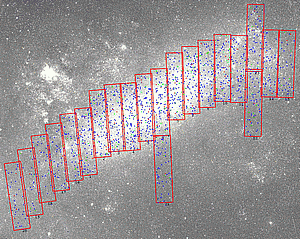Ellipsoidal Variability of Red Giants in the Large Magellanic Cloud
We used the OGLE-II and OGLE-III photometry of red giants in the Large Magellanic Cloud to select and study objects revealing ellipsoidal variability. We detected 1546 candidates for long period ellipsoidal variables and 121 eclipsing binary systems with clear ellipsoidal modulation. The ellipsoidal red giants follow a period-luminosity (PL) relationship (sequence E), and the scatter of the relation is correlated with the amplitude of variability: the larger the amplitude, the smaller the scatter.

We note that some of the ellipsoidal candidates exhibit simultaneously OGLE
Small Amplitude Red Giants pulsations. Thus, in some cases the Long
Secondary Period (LSP) phenomenon can be explained by the ellipsoidal
modulation.
We also select about 1600 red giants with distinct LSP, which are not
ellipsoidal variables. We discover that besides the sequence D in the PL
diagram known before, the LSP giants form additional less numerous sequence
for longer periods. We notice that the PL sequence of the ellipsoidal
candidates is a direct continuation of the LSP sequence toward fainter
stars, what might suggest that the LSP phenomenon is related to binarity
but there are strong arguments against such a possibility.

About 10% of the presented light curves reveal clear deformation by the
eccentricity of the system orbits. The largest estimated eccentricity in
our sample is about 0.4.
All presented data, including individual BVI observations and finding
charts are available from
the
OGLE
Internet archive.
Full resolution paper is available
from
the OGLE Internet archive.

PLEASE cite the following paper when using the data or referring to these
OGLE results:
Soszyński et al., 2004,
Acta Astron., 54, 347.
 back
back